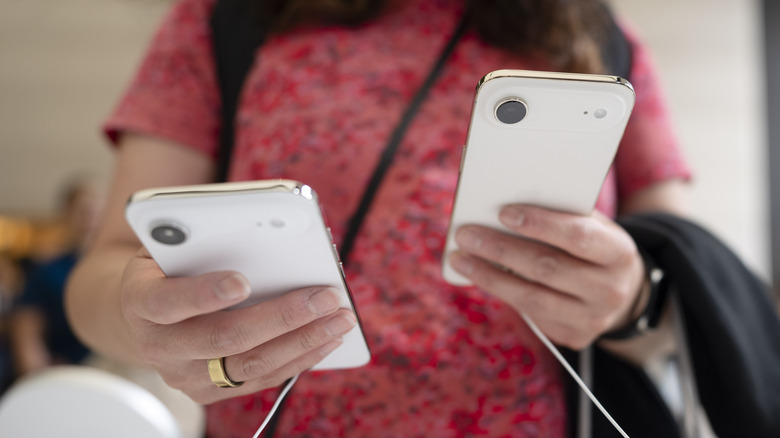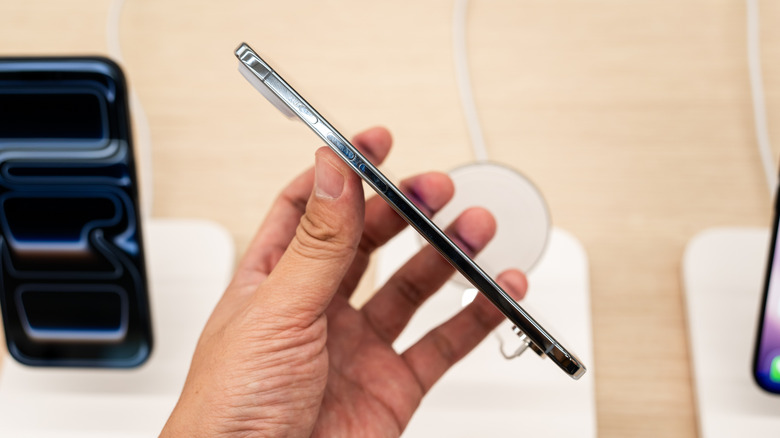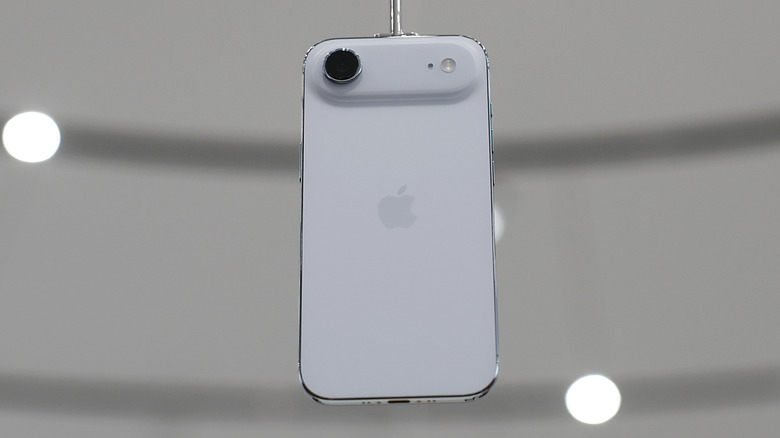Yes, The iPhone Air Is The Thinnest iPhone Ever - But There's A Catch
Every year, it seems like Apple introduces "the thinnest iPhone ever designed," and the release of the iPhone 17 lineup is no exception. The new iPhone 17 Air doesn't just boast a 6.5-inch display, the A19 Pro processor, and 12GB of RAM; Apple is also touting that the device's thickness measures a paltry 5.6mm. This makes it the thinnest and most durable iPhone to date — so long as you're not counting the device's prominent bump that houses its single 48-megapixel fusion camera.
A camera bump — the protruding area on the back of a smartphone that houses the camera -– is rarely considered when companies advertise device measurements, Apple included. However, one Reddit user ran the actual numbers, and if you factor the camera bump on the iPhone Air 17, then the total thickness changes drastically. Though the 5.64mm body of the iPhone 17 Air is still incredibly thin, the 5.68mm camera bump practically doubles the size at the top of the device.
It may seem like cheating to not include the camera bump when measuring a device, but the tech that goes into a camera can force manufacturers to vary camera bump sizes due to the components inside. Since there's no universally agreed upon standard for measuring a smartphone – protrusions and all – manufacturers typically use the body of a device as the standard for thickness.
The iPhone Air's camera bump isn't included in measurements
So long as you don't include the camera bulge, then yes, the iPhone 17 Air is Apple's thinnest phone to date. The main housing of the device is a lean 5.64mm, but the 5.68mm camera bump brings the thickness of the device to a total of 11.32mm. Factoring the camera bump into the equation actually changes quite a few things when it comes to the thinnest iPhone.
By adding the camera bump into the mix, the "true" thickness of the iPhone 17 Air puts it just below the baseline iPhone 17, which comes in at 11.4mm. Meanwhile, the 17 Pro and 17 Pro Max iPhones are both a beefy 13.18mm. If we're talking a truly thin phone, then the iPhone 5, iPhone 5s, and the first-gen iPhone SE would take home the top prize for their incredibly thin 7.6mm bodies — that's including the camera bump, which hardly even exists on these models.
In fact, if you don't include the original iPhone and iPhone 3G, then there isn't a single iPhone that jumps over the 10mm line until you reach the iPhone 12 Pro Max, which comes in at 10.18mm in total. The iPhone 13 mini and the iPhone 16e, coming in at 9.13mm and 9.48mm, respectively, would then be the only devices from the modern generation that get under 10mm in thickness, even when including the camera bump.
Camera size matters to consumers
Unfortunately, camera bumps are still a necessary evil within the world of smartphones. There's two major reasons they exist in the first place, and both involve the quality of the camera. As camera tech advances — and raises consumers' expectations — the need for better image sensors and optical zoom functions also increases. Image sensors help bring more light to a photo, improving its image quality but increasing the size of the tech, whereas the optical zoom functions also increase the size of the bump but deliver better zoom options.
The real estate available inside a smartphone body is already at a premium due to the number of components required, and cameras only further complicate the issue. Since every smartphone manufacturer aims to make the thinnest body they can for a device, sacrifices need to be made somewhere. While excluding the camera bump in measurements gives some companies a marketing edge, it also gives a reliable baseline for comparing industrial designs.
The design of the iPhone 17 Air is indeed a technological marvel, even if Apple did have to increase the camera bump on the device to accommodate the single 48MP fusion camera. Until camera technology is able to shrink itself down to compete with the rest of a smartphone's incredibly small components, you're likely to see camera bumps for quite some time. However, that doesn't mean the design of the iPhone 17 Air is something to dismiss, as Apple still managed to design a super thin phone with an impressive amount of force needed to break it.


